Developers Show Off Big Plans for Housing in Santa Barbara County
County Hosts ‘Beauty Contest’ for Housing Projects That Could Bring Thousands of Units Through Rezoning

With the County of Santa Barbara just weeks away from beginning the process of choosing which sites are to be rezoned in the name of housing, there was still little known about what these potentially community-changing developments — many of which were proposed for the areas just outside Goleta city limits — would actually look like.
Then, following a suggestion from housing advocates with the League of Women Voters of Santa Barbara, Supervisor Laura Capps called for a public hearing where developers asking to rezone land for housing would present their projects out in the open for everybody to see — and, hopefully, to help the board answer the question of whether these projects would actually produce the affordable housing that the county so badly needs.
On Tuesday, these developers went before the County Board of Supervisors one by one, each showing renderings of their grand visions for brand-new housing communities and promising to bring hundreds, if not thousands, of potential housing units to the unincorporated areas of the county. But while many of the proposals were received well by the board, it soon became clear that it would be tough to get private developers to willingly offer anything more than a small portion of units designated toward lower-income renters. Most included up to 20 percent affordable while expecting to offer the rest at market-rate.
The developer “beauty contest,” as it was described by Supervisor Bob Nelson, was just an informative session, and though the board took no action, it served as the last official chance for discussion before the County Planning Commission begins deciding on rezones during its March 27 and April 1 meetings.
All of the sites fit the county’s “rezone criteria,” according to Planning Director Lisa Plowman, which required that the proposals offer price-restricted, low-income housing, workforce housing, and on-site recreation, and that all developers partner with local nonprofits to assist with affordable units.
Some of the projects had already been in the pipeline, such as the Bailard Avenue project just outside Carpinteria, a joint effort between Red Tail Multifamily Development and the Housing Authority of the County of Santa Barbara that would convert a property formerly owned by Carpinteria Unified School District into a mix of market-rate and affordable housing.
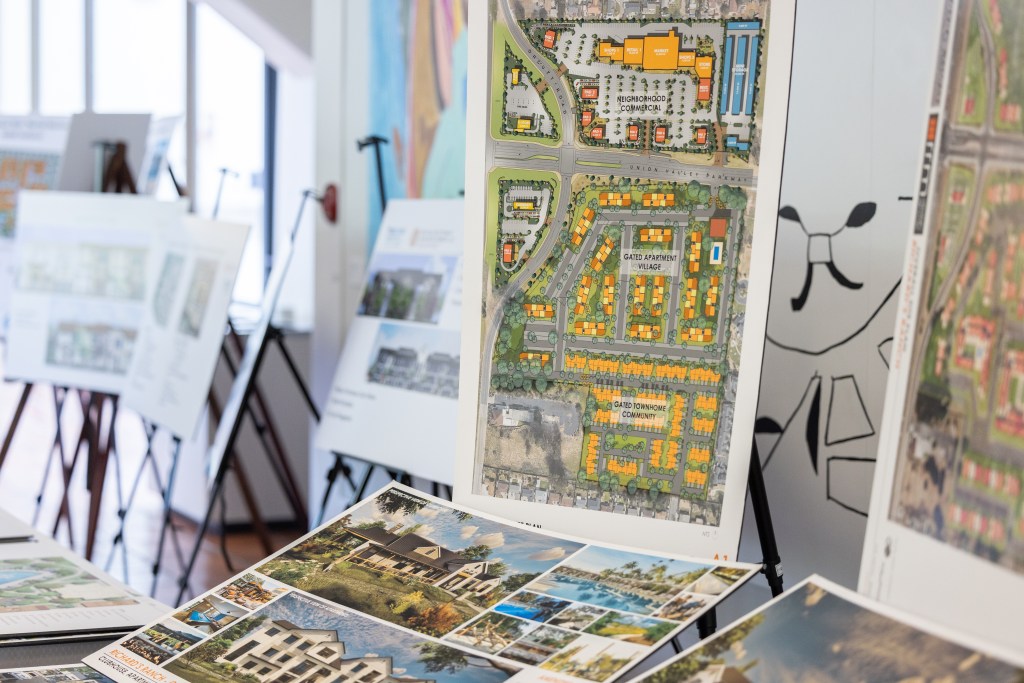
The site was originally proposed at 173 units — 41 low-income and 132 market-rate — with Red Tail managing the market-rate portion of the property and the Housing Authority handling the affordable housing section. But with the county’s approval for a rezone, the developers are hoping to expand to 182 units, with 50 designated for very-low- and low-income renters and the remaining 132 units at market rate.
By working directly with the Housing Authority, which already manages more than 1,500 units of affordable housing in the county and has a wait list of more than 9,000 people, the Bailard Property could also offer on-site mental-health services and resident resources. Affordable units would be set aside for individuals trying to transition out of homelessness and qualified low-income families.
The majority of the rezone proposals came in the areas of the county right outside the City of Goleta. These included six sites within a mile and a half area in the Eastern Goleta Valley.
The Tatum property, tucked between El Camino School and Turnpike Shopping Center, is strikingly similar to the Bailard project. Both are former school district properties, and both were proposed as new developments during the most recent eight-year housing element planning cycle. Both are not zoned as agricultural — which was a major sticking point for county officials hoping to preserve ag lands — and both are collaborations between Red Tail and the Housing Authority.
The team behind the Tatum property, like Bailard, is also asking for a rezone to bring even more units than originally planned. Previously, the project was submitted as a 345-unit project with at least 69 affordable units and 275 market-rate; with the county’s approval of a rezone, that number would balloon to 545 units across the 23 acres, with 110 considered affordable and 435 available at market rate.
Just across the street from the Tatum property is the proposed San Marcos Growers site, owned by the Hodges family since 1979. Although it was originally zoned as residential, it has operated as a wholesale nursery and was zoned as agricultural in 1993. Now, the Hodges family is hoping to convert the 27 acres into 996 units of housing, with 200 deed-restricted to very-low- and low-income renters and the remainder offered as “upper-moderate- income workforce housing,” according to project planner John Blair of Presidio Capital Partners.
Like the Tatum property, the site location near Hollister Avenue is in a prime position for large-scale development, already surrounded by residential and commercial properties and right along a major transit corridor. The developers described the project as “shovel ready,” hoping to be first to build in the Eastern Goleta housing rush.
Like many of the other proposals, San Marcos Growers had a vision of an “environmentally friendly apartment community,” complete with dog parks, community trails, and open spaces. And like the others, the Housing Authority would handle the affordable portion on a separate parcel — a trend that has become necessary due to state guidelines requiring separate parcels for housing built with tax credits.
The San Marcos site is also among several sites included in the newly created South Coast Chamber of Commerce housing consortium, which will bring housing providers together with local businesses to subsidize units for employees.

Right across the property line on Hollister Avenue, on an 11-acre property owned by Montessori Center School, developers are proposing a 345-unit development with a mix of low- and moderate-income and market-rate housing.
Across Hollister on the South side of Patterson Avenue, the Caird family, who has owned Por La Mar Nursery since the early 1970s, is proposing more than 800 homes with a mix of lower-density, single-family homes and more densely packed multifamily homes ranging from two to four stories tall.
A bit farther down Hollister Avenue is a proposal for 317 units of garden-style apartments across 15 acres owned by St. Athanasius Church. Developers are hoping to be approved for a rezone before exploring the level of affordability.
But the darling of the show, listed as number one on the county’s list of potential rezones, is the 64 acres of avocado and lemon orchards at the intersection of Hollister and Ward Memorial Drive owned by the Giorgi family. The property could potentially be the future home of nearly 1,200 units of housing, with nine different types of housing, both rentals and for sale, in what project planner Jeff Nelson of Oak Creek Company called a “diverse, fully planned, new community.”
The massive project boasts 600 units of rentals and 590 units for sale. Two hundred and fifty of the rentals would be set aside for affordable housing, and a portion of the for-sale units would be catered to moderate-price workforce housing. The early renderings show pocket parks, two-story townhomes, three- and four-story affordable apartment buildings, commercial spaces, and even a childcare and preschool on-site. The developers were also among those willing to work with the South Coast Chamber of Commerce to ensure workforce housing.
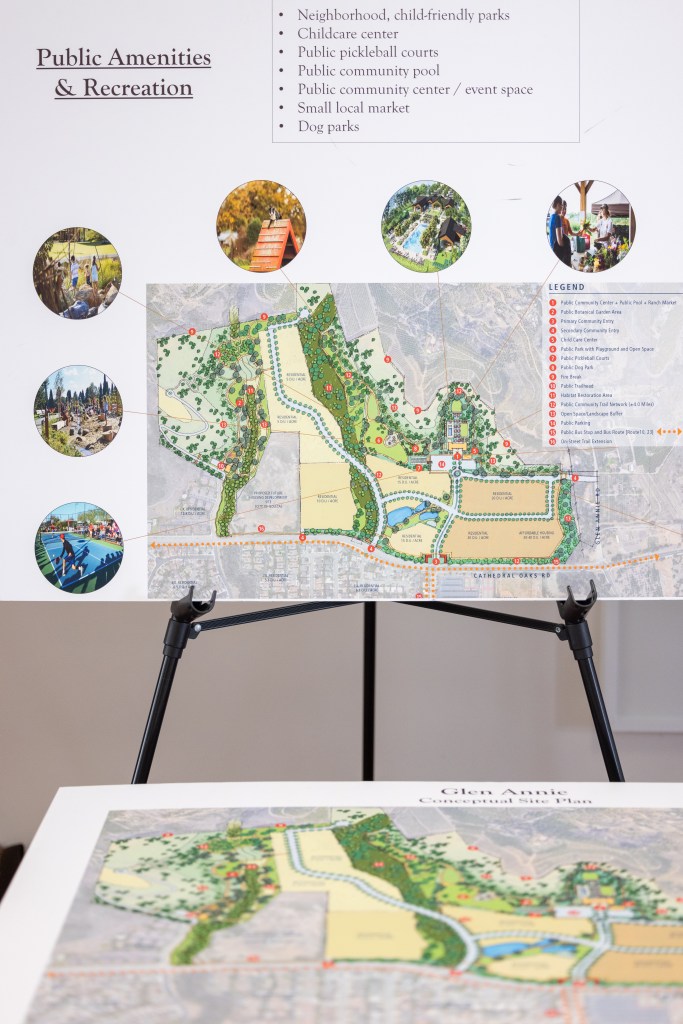
Some of the proposals raised concerns from community members worried that the statewide push for housing is causing the county to build too much too fast. During public comment, community members spoke out against the proposed development of the Glen Annie Golf Course, whose owners are considering a project with more than a thousand units with a mix of rentals and for-sale units. The proposal would require the closure of the golf course in favor of an entirely new neighborhood, complete with pickleball courts, park trails, a grab-and-go market, and the obligatory on-site dog parks.
Dianne Black, a retired director of the county’s Planning and Development department who now sits on the housing committee for the League of Women Voters, said that she was encouraged to see a mix of affordable and for-sale housing, though she pointed out that the amount of affordable units being offered was still far below the county’s goals for developments to provide 50 percent of units for lower-income, 25 percent for moderate, and 25 percent for market-rate.
“None of these projects meet that,” Black said. “Not one.”
She also pointed out that even without rezones, the county is projected to be well over the target of market rate units for the next eight years, and accommodating even more rezone sites would “result in significant overdevelopment” of market-rate units. To offset this, she says the League of Women Voters “strongly recommends that the county immediately investigate additional sites owned by the county and other public agencies for affordable housing.”
Supervisor Capps said that having the developers present their projects in front of the public was “a huge step forward in terms of transparency,” though she said she hoped to see much more affordable housing, and suggested that the county require a letter of intent to ensure the projects provided the affordability as promised.
“I’ve said it before, but affordability is by far the top priority,” Capps said. “How do we know that these promises of affordability will stick?”
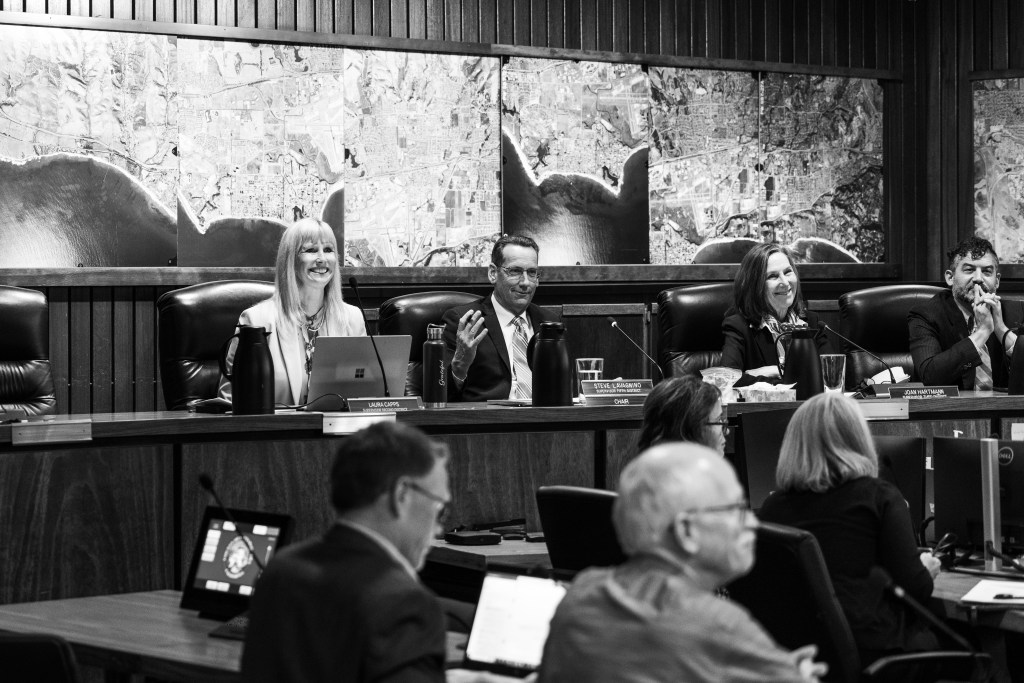
Visit the county’s YouTube page to see the presentations in full.
Premier Events
Sun, Apr 28
6:00 PM
Santa Barbara
AHA! Presents: Sing It Out!
Thu, May 02
5:00 PM
Santa Barbara
Things with Wings at Art & Soul
Sat, May 04
10:00 AM
Lompoc
RocketTown Comic Con 2024
Sat, Apr 27
11:00 AM
Santa Barbara
Santa Barbara Plant Fest
Sat, Apr 27
3:30 PM
Santa Barbara
Santa Barbara Trapeze Co and Unity Shoppe Spring Food Drive
Sat, Apr 27
8:00 PM
Santa Barbara
Beau James Wilding Band Live
Sun, Apr 28
11:00 AM
Santa Barbara
Santa Barbara Earth Day Festival 2024
Wed, May 01
7:30 PM
Santa Barbara
American Theatre Guild Presents “Come From Away”
Thu, May 02
5:00 PM
Santa Barbara
100th Birthday Tribute for James Galanos
Thu, May 02
5:00 PM
Santa Barbara
Meet the Creator of The Caregiver Oracle Deck
Fri, May 03
4:00 PM
Santa Barbara
Santa Barbara Fair+Expo “Double Thrill Double Fun”
Fri, May 03
8:00 PM
Santa barbara
Performance by Marca MP
Sat, May 04
10:00 AM
Solvang
Touch A Truck
Sun, Apr 28 6:00 PM
Santa Barbara
AHA! Presents: Sing It Out!
Thu, May 02 5:00 PM
Santa Barbara
Things with Wings at Art & Soul
Sat, May 04 10:00 AM
Lompoc
RocketTown Comic Con 2024
Sat, Apr 27 11:00 AM
Santa Barbara
Santa Barbara Plant Fest
Sat, Apr 27 3:30 PM
Santa Barbara
Santa Barbara Trapeze Co and Unity Shoppe Spring Food Drive
Sat, Apr 27 8:00 PM
Santa Barbara
Beau James Wilding Band Live
Sun, Apr 28 11:00 AM
Santa Barbara
Santa Barbara Earth Day Festival 2024
Wed, May 01 7:30 PM
Santa Barbara
American Theatre Guild Presents “Come From Away”
Thu, May 02 5:00 PM
Santa Barbara
100th Birthday Tribute for James Galanos
Thu, May 02 5:00 PM
Santa Barbara
Meet the Creator of The Caregiver Oracle Deck
Fri, May 03 4:00 PM
Santa Barbara
Santa Barbara Fair+Expo “Double Thrill Double Fun”
Fri, May 03 8:00 PM
Santa barbara
Performance by Marca MP
Sat, May 04 10:00 AM
Solvang


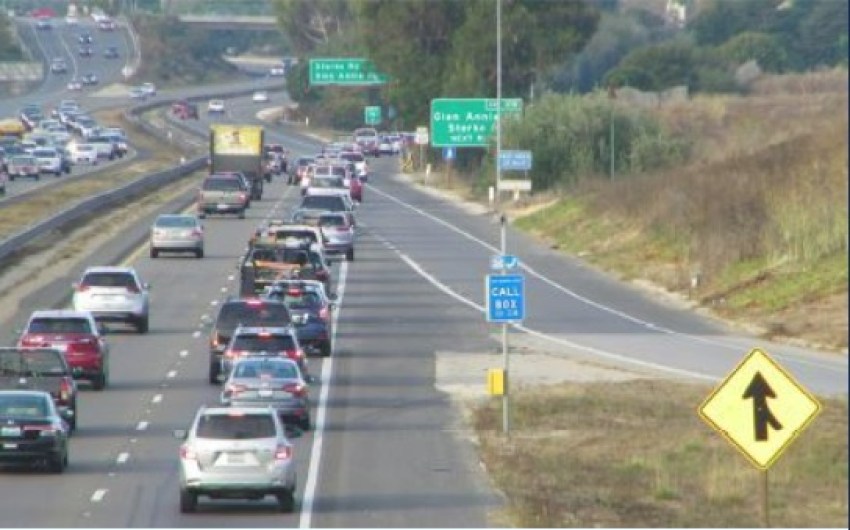
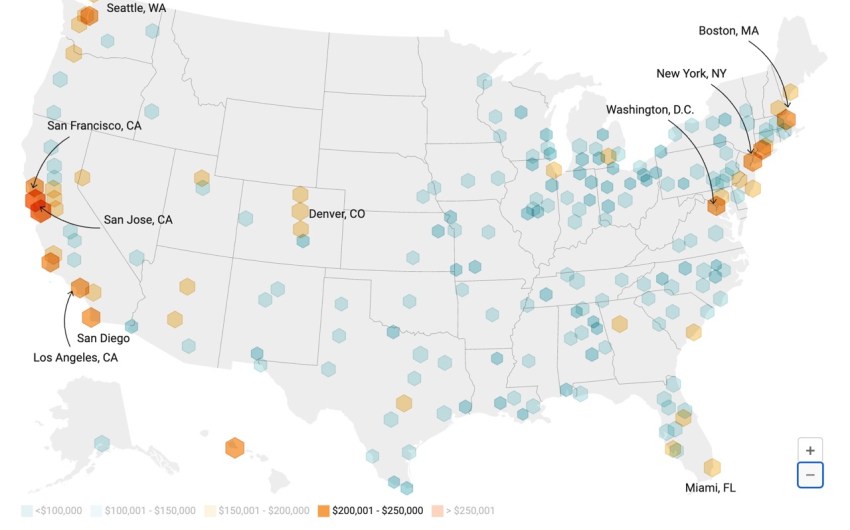






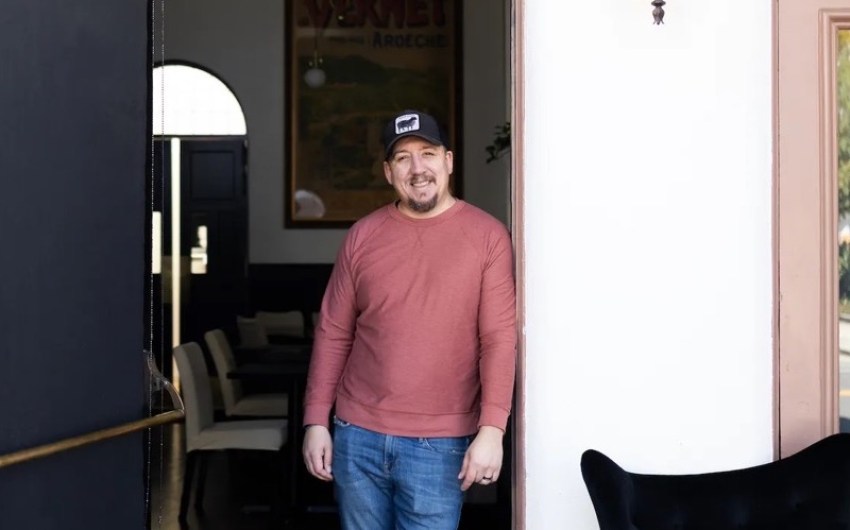

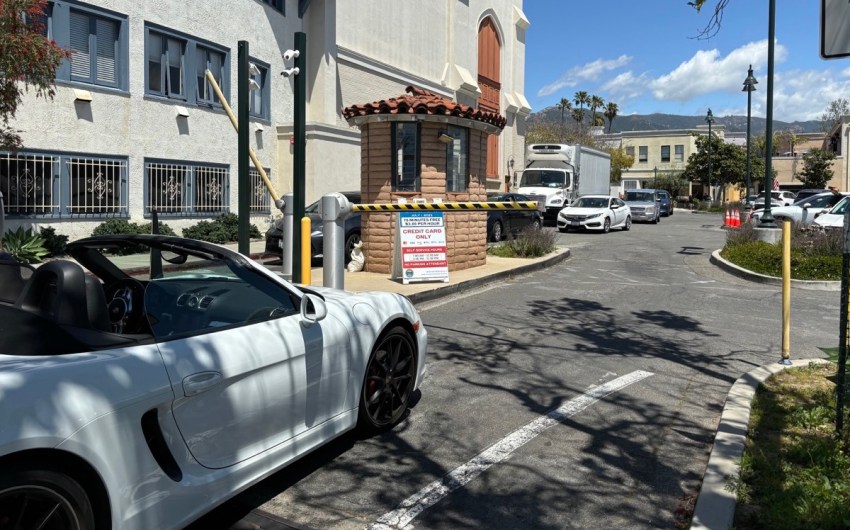













You must be logged in to post a comment.